I never know what I might find when I go fishing, but I never expected to find a sea serpent, with three-inch teeth. Thank goodness, I was fishing in the newspaper archive. I was searching for something about Fishers Landing and came across this article:
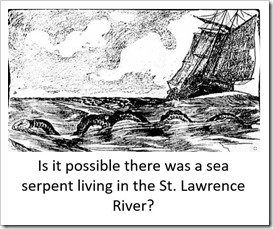 Great excitement at Fisher’s Landing! A “Sea Serpent” or some other large monster, was seen near that place by a fisherman, who, seeing what he supposed to be a log, took his boat and went out to get it for firewood. When some little distance from the supposed log, what was his surprise to see it coming toward him with mouth open and displaying rows of teeth about three inches long. Mr. Fisherman was reminded by this time that he had plenty of wood at home, and he sought his little cot by the hillside and the monster went down. The next account we get in from a party returning to Fisher’s Landing from Grinnell’s Island, when the monster put in his appearance alongside of them with mouth wide open and large enough. We cannot vouch for this, although we think it true.
Great excitement at Fisher’s Landing! A “Sea Serpent” or some other large monster, was seen near that place by a fisherman, who, seeing what he supposed to be a log, took his boat and went out to get it for firewood. When some little distance from the supposed log, what was his surprise to see it coming toward him with mouth open and displaying rows of teeth about three inches long. Mr. Fisherman was reminded by this time that he had plenty of wood at home, and he sought his little cot by the hillside and the monster went down. The next account we get in from a party returning to Fisher’s Landing from Grinnell’s Island, when the monster put in his appearance alongside of them with mouth wide open and large enough. We cannot vouch for this, although we think it true.
What a discovery! Not one, but two reported sea serpent sightings on a route I have traveled a thousand times—the one between Fishers Landing and Grenell Island. After I recovered from the shock, I took note of two interesting facts. First, the second party was returning from “Grinnel’s island” — perhaps having imbibed at Sam’s Tavern? Next, I focused on the title: The Sea Serpent Again. Again? This is not the first sea serpent sighting in the St. Lawrence?
I went back to the newspaper archives looking for earlier sea serpent sightings and found another account from six years earlier. This one was a first-hand account by a journalist. While not exactly in the St. Lawrence, it was near the mouth of the St. Lawrence in Lake Ontario, a mere 18 miles as the crow flies from Fishers Landing, a bit longer as the sea serpent swims.xxx<
Mexico Independent, July 7, 1877
A writer in the Watertown Times while sailing in company with some young ladies on Chaumont Bay last week saw a huge sea serpent which appeared to him to be about the size of the “hull” of a small schooner. He says: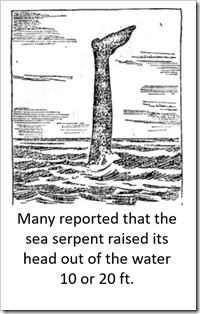
“You can imagine the consternation that appeared on the countenances of the whole party, when the serpent seemed to turn and come directly toward us. The head seemed to raise to the height of at least 20 feet, and immediately we heard a tremendous roar, the forward feet of the monster beginning to beat the water in front of him, creating a foaming and roaring which sounded like tremendous falls. The tail of the animal, which seemed to be at least 20 or 30 feet in length, was lashing the water in all directions.”
Searching further back into the archives, the earliest newspaper article I found was from 1821. This time, 10 witnesses in a voyager canoe saw a sea serpent, which had been seen earlier in the year, “ascending the St. Lawrence.” Two of the witnesses were not only willing to put their name on the record, but sign an affidavit in front of a judge.
Oswego Palladium, September 14, 1821
The Sea Serpent Navigating the Western Lakes
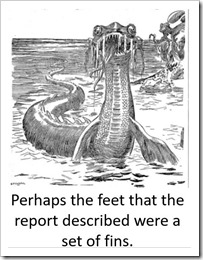 That on the morning of 25th July, 1821, about one hundred miles from Niagara and about 20 from land aboard the canoe Lightfoot, on our passage from Montreal to Mackinac, in company with eight voyagers, we discovered at the distance of five or six hundred yards a large body floating on the surface of the water, very much like a burnt log from 20 to 25 feet length; but on approaching it three or four hundred yards closer, it proved to be an animal motionless and apparently asleep. We continued to advance towards it until within 30 yards, when the animal raised its head about 10 feet out of the water, looking around him in the most awful and ferocious manner, and darting forward with great velocity, making the water fly in every direction, and throwing columns of it at a vertical height of seven or eight feet with his tail.
That on the morning of 25th July, 1821, about one hundred miles from Niagara and about 20 from land aboard the canoe Lightfoot, on our passage from Montreal to Mackinac, in company with eight voyagers, we discovered at the distance of five or six hundred yards a large body floating on the surface of the water, very much like a burnt log from 20 to 25 feet length; but on approaching it three or four hundred yards closer, it proved to be an animal motionless and apparently asleep. We continued to advance towards it until within 30 yards, when the animal raised its head about 10 feet out of the water, looking around him in the most awful and ferocious manner, and darting forward with great velocity, making the water fly in every direction, and throwing columns of it at a vertical height of seven or eight feet with his tail.
After having gone in a western direction about one or two miles, he appeared to resume his former state, we then resolved to attack him, and accordingly loaded our guns for this purpose, and moved slowly toward him with gun shot.
We here had a good view of the animal, he is at least thirty-seven feet long, two and a half feet in diameter, (if measured through the thickest part of the body) is covered with black scales which appeared to create consternation only, he disappearing as before—he has a tremendous head and similar to that of a common snake—frequently thrusting from his mouth a large red and venomous looking tongue. After the animal disappeared we continued our course with a lively oar as may well be imagined.
His figure when in motion is serpentine.
__________________
Another Oswego Palladium article was written in 1833, 12 years later, gave my favorite description of the sea serpent. Captain Abijah Kellogg, of the schooner Polythermus, of Sackets Harbor saw the sea serpent near Kingston. He said the sea serpent had monstrous dimensions. It was about 175 feet long and the middle of its body was the circumference of a barrel. He described the head as being “peculiarly small.” Captain Kellogg said the serpent was a dark blue color, spotted with brown. The serpent swam with an undulating movement, keeping the “best part” of its body under water, but sometimes showing its entire length. This is the only description of the sea monster as a blue creature. Most eye-witnesses described it as black.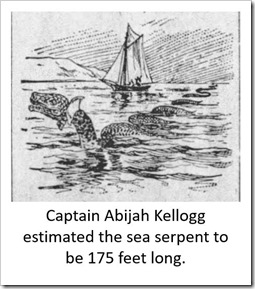
Captain Kellogg, along with two crew and three passengers, watched the creature for over fifteen minutes. Finally, the serpent disappeared from sight, last seen swimming down the St. Lawrence.
This was the first recorded sighting near Kingston. Between 1833 and 1933 there were hundreds of sightings, enough for the sea serpent to earn the nickname, Kingstie. The reports usually describe a snake-like creature 20 – 40 feet long. Some say it had a head like a dog, while others described it as being more alligator-like. One eye-witness account described the serpent as having devilish green eyes. Another said the beast had horns. Still others said there was a fin or ridge along its back. Nearly all initially mistook the sea serpent for a log, floating on the surface, until it began to move. When threatened, it was often described as lashing its tail back and forth until the water was foamy. Sometimes it was described as having teeth. Several said it emitted a terrible roar. Only the witness from Chaumont Bay described the serpent as having feet.
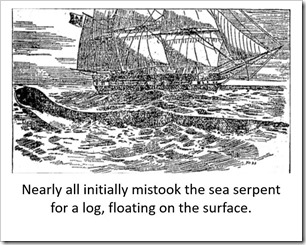 Sea Serpent sightings seemed to be a summer phenomenon. A quote in the 1887 Watertown Herald states: “There is no doubt that summer is here in earnest. The sea serpent has begun to show up.” But then this was at the height of the popularity of the Thousand Islands. With more people on the water, there were more possibilities of seeing the sea serpent.
Sea Serpent sightings seemed to be a summer phenomenon. A quote in the 1887 Watertown Herald states: “There is no doubt that summer is here in earnest. The sea serpent has begun to show up.” But then this was at the height of the popularity of the Thousand Islands. With more people on the water, there were more possibilities of seeing the sea serpent.
Serpent sightings swelled in 1888. In June, there was a sea serpent sighting in Cape Vincent. In July, a fisherman and guide between Round Island and a marsh near the New York mainland saw a sea serpent. The Watertown Times reported: “When about forty yards from the marsh, Mr. Sikes says he saw something black moving quite rapidly on top of the water. At first, he thought it was a duck or some other species of waterbird, but it was nothing of the sort. It was, as he believed, the head of a water serpent of enormous size. The head went at least eight inches across the top and stuck out of the water a foot or more. The head went under when the boat was about forty yards from it. As it disappeared, the water was ruffled by the serpent’s tail at least thirty feet from the spot. The serpent did not reappear, but the man who saw it believed it has not left that part of the River.”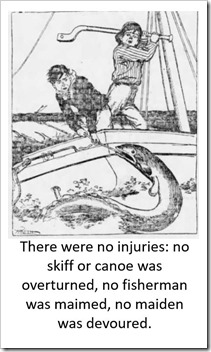
In August, two men canoeing near Milton Island, near Kingston reported seeing a snake-like creature. “The monster passed us so close when we stopped, that we could see him distinctly and judged him to be at least fifteen feet long. He was six feet out of the water. I am sure it was no seal or fish I ever saw. It looked too snaky. When he disappeared, after remaining in sight four or five minutes and moving very rapidly, we started off lest he might upset the canoe. I will admit that we were considerably frightened. As he disappeared, he switched his tail violently, making a loud report.” The same witness went on to speculate that the serpent fed on the carcasses of dead animals thrown along the shore by farmers.
In 1888, a correspondent from Thousand Island Park reported that Sea Serpent hysteria was at its peak. “Young ladies in the islands refuse to go out in anything but steam yachts having high gunwales and skiff owners are taking a rest.”
 If Kingstie truly did exist, it liked to roam. There have been reports of sea serpents from seaside resorts from Nova Scotia to Coney Island. Inland, sea serpents were sighted as far west as Lake Superior, north into Canada, on the Rideau Lakes, as well as to the south in the Hudson River and even the Erie Canal.
If Kingstie truly did exist, it liked to roam. There have been reports of sea serpents from seaside resorts from Nova Scotia to Coney Island. Inland, sea serpents were sighted as far west as Lake Superior, north into Canada, on the Rideau Lakes, as well as to the south in the Hudson River and even the Erie Canal.
The last sighting of Kingstie in 1935, proved to be a hoax. But does that prove they were all hoaxes? The eyewitness statements I’ve read seemed genuine. I think they all believed they saw a large snake-like creature. Was it mass hysteria? Was the St. Lawrence Sea Monster the UFO sightings of the 19th century?
The only good news from all of these reports is that there were no injuries: no skiff or canoe was overturned, no fisherman was maimed, no maiden was devoured. Has the sea serpent died out, a victim of loss of habitat? Perhaps dams downriver prevent the sea serpent access to the sea, and it is content staying in the depths of Lake Ontario these days.
Still, I’ll keep my eyes peeled when I’m crossing from Fishers Landing to Grenell, when I return to the islands in May. Meanwhile, I’ll sit back and fish around in the newspaper archives, to see what other fantastic stories I can find, about our beloved Thousand Islands.
By Lynn E. McElfresh, Grenell Island.
Lynn McElfresh has not shirked her TI Life responsibilities this winter… This article is not only interesting, but gives us food for thought for Summer 2018. I, for one, will be watching out for a whole new creature – as if Goby Fish and zebra mussels are not enough! This is Lynn’s 110th article; let us know if you too, have seen one of these creatures recently!
Thanks again Lynn… You can see all of Lynn’s articles here. (We celebrated her #80 in July, 2015!)